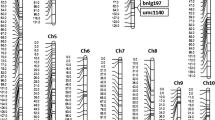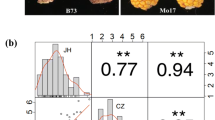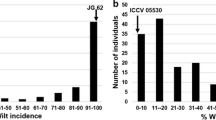Abstract
Fusarium ear rot caused by Fusarium verticillioides is a prevalent disease in maize which can severely reduce grain yields and quality. Identification of stable quantitative trait loci (QTL) for resistance to Fusarium ear rot is a basic prerequisite for understanding the genetic mechanism of resistance and for the use of marker-assisted selection. In this study, two hundred and ten F 2:3 families were developed from a cross between resistant inbred line BT-1 and susceptible inbred line Xi502, and were genotyped with 178 simple sequence repeat markers. The resistance of each line was evaluated in two environments by artificial inoculation using the nail-punch method. The resistance QTL were detected using the composite interval mapping method. Three QTL were detected on chromosomes 4, 5 and 10. Of them, the QTL on chromosome 4 (bin 4.05/06) had the largest resistance to Fusarium ear rot, and could explain 17.95 % of the phenotypic variation. For further verification of the QTL effect, we developed near-isogenic lines (NILs) carrying the QTL region on chromosome 4 using parental line Xi502 as the recurrent parent. In the NIL background, this QTL can increase the resistance by 33.7–35.2 % if the resistance region is homozygous, and by 17.8–26.5 % if the resistance region contains the heterozygous allele. The stable and significant resistance effect of the QTL on chromosome 4 lays the foundation for further marker-assisted selection and map-based cloning in maize.

Similar content being viewed by others
References
Ali ML, Taylor JH, Jie L, Sun G, William M, Kasha KJ, Reid LM, Pauls KP (2005) Molecular mapping of QTLs for resistance to Gibberella ear rot, in corn, caused by Fusarium graminearum. Genome 48:521–533
Andersen JR, Lübberstedt T (2003) Functional markers in plants. Trends Plant Sci 8:554–560
Chen W, Wu JY, Yuan HX (2002) Identification of resistance on maize germplasm to maize ear rot. J Maize Sci 10:59–60
Churchill GA, Doerge RW (1994) Empirical threshold values for quantitative trait mapping. Genetics 138:963–971
Ding JQ, Wang XM, Chander S, Yan JB, Li JS (2008) QTL mapping of resistance to Fusarium ear rot using a RIL population in maize. Mol Breed 22:395–403
Drepper WJ, Renfro BL (1990) Comparision of methods for inoculation of ears and stalks of maize with Fusarium moniliforme. Plant Dis 74:952–956
Dutton MF (1996) Fumonisins, mycotoxins of increased importance: their nature and their effects. Pharmacol Ther 70:137–161
Gelderblom WCA, Jaskiewicz K, Marasas WFO, Thiel PG, Horak RM, Vleggaar R, Kriek NP (1988) Fumonisins: novel mycotoxins with cancer-promoting acitivity producted by Fusarium moniliforme. Appl Environ Microbiol 54:1806–1811
Gong ZH, Cecchini E, Milner JJ (1997) A new method of DNA extraction for identification of transgenic plants with PCR. Acta Univ Agric. Boreali-occidentalis 25:45–48
Ho WC, Ko WH (1997) A simple method for obtaining single-spore isolates of fungi. Bot Bull Acad Sin 38:41–44
Knapp SJ, Stroup WW, Ross WM (1985) Exact confidence intervals for heritability on a progeny mean basis. Crop Sci 25:192–194
Kosambi DD (1944) The estimation of map distances from recombination values. Ann Eugen 12:172–175
Lander ES, Green P, Abrahanson J (1987) MAPMAKER: an interactive computer package maps of experimental and natural populations. Genomics 1:174–181
Li ZM, Ding JQ, Wang RX, Chen JF, Sun XD, Chen W, Song WB, Dong HF, Dai XD, Xia ZL, Wu JY (2011) A new QTL for resistance to Fusarium ear rot in maize. J Appl Genet 52(4):403–406
Liang HW, Wang CZ, Li Z, Luo XZ, Zou GW (2008) Improvement of the silver-stained technique of polyacrylamide gel electrophoresis. Hereditas (Beijing) 30:1379–1382
Löffler M, Kessel B, Ouzunova M, Miedaner T (2010) Population parameters for resistance to Fusarium graminearum and Fusarium verticillioides ear rot among large sets of early, mid-late and late maturing European maize (Zea mays L.) inbred lines. Theor Appl Genet 120:1053–1062
Löffler M, Kessel B, Ouzunova M, Miedaner T (2011) Covariation between line and testcross performance for reduced mycotoxin concentrations in European maize after silk channel inoculation of two Fusarium species. Theor Appl Genet 122:925–934
Martin M, Miedaner T, Dhillon BS, Ufermann U, Kessel B, Ouzunova M, Schippracka W, Melchinger AE (2011) Colocalization of QTL for Gibberella ear rot resistance and low mycotoxin contamination in early european maize. Crop Sci 51:1935–1945
Martin M, Miedaner T, Schwegler DD, Kessel B, Ouzunova M, Dhillon BS, Schippracka W, Utza HF, Melchinger AE (2012) Comparative quantitative trait loci mapping for Gibberella ear rot resistance and reduced deoxynivalenol contamination across connected maize populations. Crop Sci 52:32–43
Mesterházy A, Lemmens M, Reid LM (2012) Breeding for resistance to ear rots caused by fusarium spp. in maize—a review. Plant Breed 131:1–19
Miller JD (2001) Factors that affect the occurrence of fumonisin. Environ Health Perspect 109:321–324
Munkvold GP (2003) Epidemiology of Fusarium diseases and their mycotoxins in maize ears. Eur J Plant Pathol 109:705–713
Munkvold GP, Desjardins AE (1997) Fumonisins in maize: can we reduce their occurrence. Plant Dis 81:556–565
Pérez-Brito S, Jeffers D, Gonzàlez-de-León D, Khairallah M, Cortés-Cruz M, Velàzquez-Cardelas G, Azpiroz-Rivero S, Srinivasan G (2001) QTL mapping of Fusarium moniliforme ear rot resistance in highland maize, México. Agrociencia 35:181–196
Reid LM, Mather DE, Bolton AT, Hamilton RI (1994) Evidence for a gene for silk resistance to Fusarium graminearum Schw. ear rot of maize. J Hered 85:118–121
Robertson-Hoyt LA, Jines MP, Balint-Kurti PJ, Kleinschmidt CE, White DG, Payne GA, Maragos CM, Molnar TL, Holland JB (2006) QTL mapping for Fusarium ear rot and fumonisin contamination resistance in two maize populations. Crop Sci 46:1734–1743
Robertson-Hoyt LA, Kleinschmidt CE, White DG, Payne GA, Maragos CM, Holland JB (2007) Relationships of resistance to Fusarium ear rot and fumonisin contamination with agronomic performance of maize. Crop Sci 47:1770–1778
SAS Institute (1999) SAS for Windows, version 8.2. SAS Institute, Inc., Cary
Weidenborner M (2001) Foods and fumonisins. Eur Food Res Technol 212:262–273
Wilke AL, Bronson CR, Tomas A, Munkvold GP (2007) Seed transmission of Fusarium verticillioides in maize plants grown under three different temperature regimes. Plant Dis 91:1109–1115
Xiang K, Zhang ZM, Reid LM, Zhu XY, Yuan GS, Pan GT (2010) A meta-analysis of QTL associated with ear rot resistance in maize. Maydica 55:281–290
Zeng ZB (1994) Precision mapping of quantitative trait loci. Genetics 136:1457–1467
Acknowledgments
This research was funded by the National Project “973’’ of China (2009CB118402). The authors would like to acknowledge Dr. Wenxuan Liu for his critical reading of the manuscript and K. Ann Bybee-Finley for her grammatical revision.
Author information
Authors and Affiliations
Corresponding author
Additional information
Jiafa Chen and Junqiang Ding contributed equally to this paper.
Rights and permissions
About this article
Cite this article
Chen, J., Ding, J., Li, H. et al. Detection and verification of quantitative trait loci for resistance to Fusarium ear rot in maize. Mol Breeding 30, 1649–1656 (2012). https://doi.org/10.1007/s11032-012-9748-1
Received:
Accepted:
Published:
Issue Date:
DOI: https://doi.org/10.1007/s11032-012-9748-1




